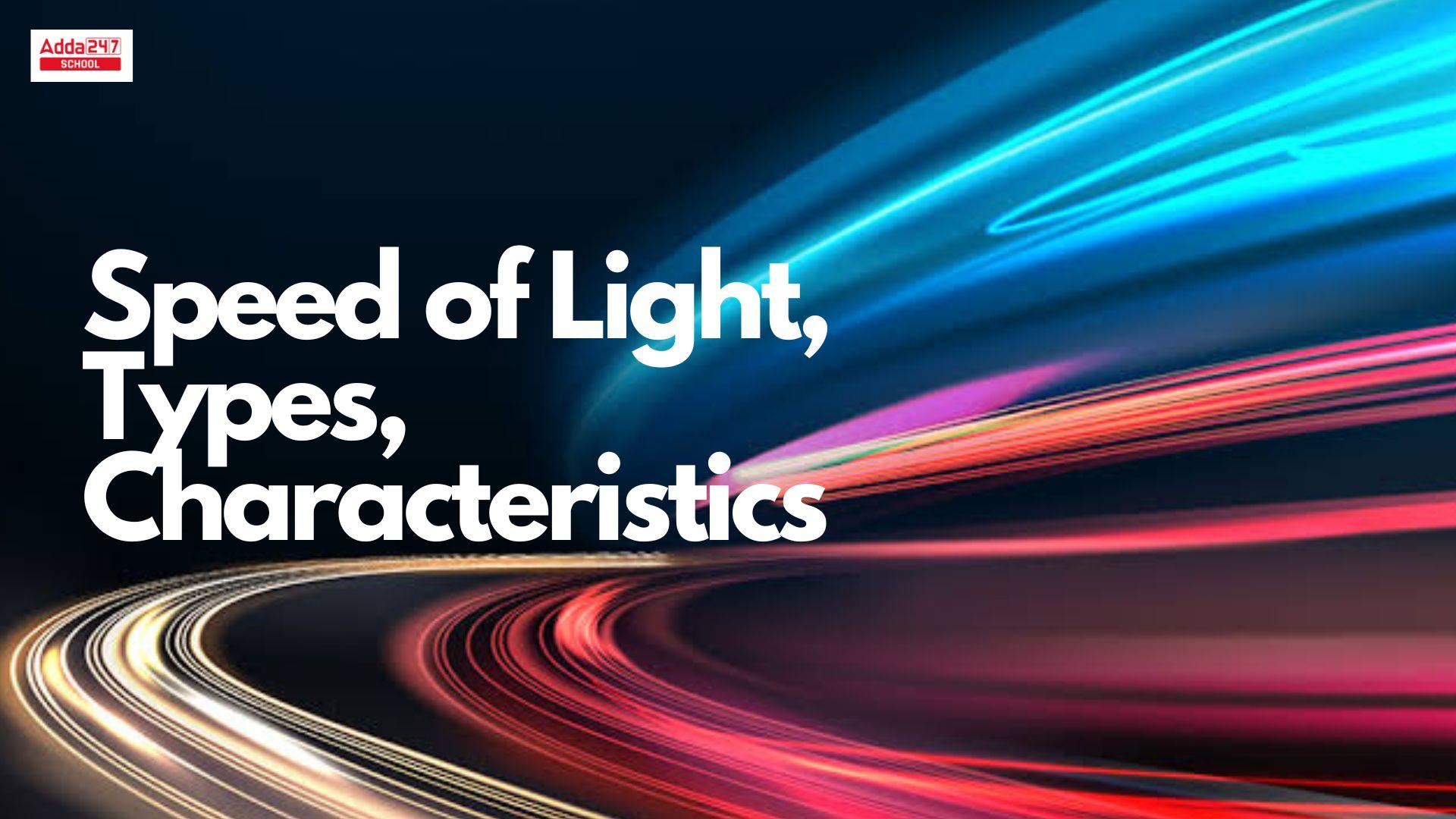Speed of Light
Speed of Light: At present, detailed information has been given about the speed of light and light under our courses. But this information is so standard and difficult that it may be difficult for a common student to understand.
That’s why in today’s article, we are going to provide you with some such important facts and information regarding the speed of light and light, which you will not even need to work hard to understand. If you also want to know about the speed of light, stay with us till the end of this article. So let’s start-
What is Speed of Light Class 9?
Light can be introduced as a form of electromagnetic radiation. This electromagnetic radiation can be seen by the naked human eye. It is a type of energy that travels in the form of waves. It has both wave-like and particle-like properties. It is made of particles called photons.
But it has no mass, only energy, and momentum. Light is a fundamental part of our lives and is responsible for our ability to perceive the world around us. It can travel at a speed of about 299792458 meters per second in a vacuum, and its speed slows down slightly when passing through other materials such as air, and water.
Light can be generated from natural sources such as the Sun, and other star systems, and unnatural or man-made sources such as light bulbs, or lasers. It plays an important role in many areas of science and technology, including optics, spectroscopy, photometry, and others.
Speed of Light Types
There are many types of light, which can be classified based on their wavelength or frequency. Here are some common lighting types:
Radio waves: Radio waves are low-frequency waves used in communications, such as radio and TV broadcasting.
Microwave: Higher frequency than radio waves and used in communications, radar, and cooking.
Infrared waves: Infrared waves emitted by hot objects are used in thermal imaging remote controls.
Colored light: The range of wavelengths of light that are visible to the human eye, including colors from red to violet.
Ultraviolet radiation: High-energy light can cause sunburn and skin cancer. But it is used for sterilization and fluorescent lighting.
X-ray radiation: High-energy electromagnetic radiation used in medical imaging and scientific research.
Gamma rays: The most energetic type of electromagnetic radiation emitted in radioactive materials and nuclear reactions.
The electromagnetic spectrum includes all of these types of light, in order from low to high frequency or longest to shortest wavelength. Each type of light has different properties and interacts with matter which is important for their applications.
Characteristics of Light Class 10
Light has many characteristics, which are important in understanding its behavior and properties, such as,
- Speed of light
- Lighting system
- Frequency of light
- Polarization of light
- Reflection of light
- Refraction of light
- Light interference
- Diffraction of light
- Absorption of light
- Dispersion of light
These are all characteristics of light and are fundamental to understanding its properties and behaviors, all of which are important in a wide range of scientific and technological applications.
Measuring The Speed of Light Project Class 12
Measuring the speed of light is a classic physics experiment that can be a great project for a class 12 student. The method you choose will depend on the equipment and resources available to you. Here’s a basic outline of a project to measure the speed of light:
Title: Measuring the Speed of Light
Objective: To measure the speed of light using a simple experimental setup.
Materials:
- A rotating mirror
- A light source (e.g., laser)
- Beam splitter
- Photodetector
- Motor to rotate the mirror
- Measuring tape or ruler
- Stopwatch
- A stable platform to mount the apparatus
Procedure:
- Set up the Apparatus:
- Mount the rotating mirror on one end of the stable platform.
- Place the light source (laser) at a suitable distance from the mirror.
- Position the beam splitter between the light source and the mirror at a 45-degree angle to the incident beam.
- Place the photodetector on the other side of the beam splitter, opposite the light source.
- Connect the rotating mirror to the motor.
- Calibrate the Apparatus:
- Make sure the rotating mirror is at rest.
- Adjust the positions of the light source and photodetector so that the reflected beam from the mirror hits the photodetector when the mirror is stationary.
- Record this distance (D) between the mirror and the photodetector.
- Measure the Time Delay:
- Start the motor to rotate the mirror at a constant speed.
- When the mirror starts moving, the reflected beam will hit a different point on the photodetector.
- Measure the time it takes for the reflected beam to move a certain distance on the photodetector. This time delay is denoted as Δt.
- Calculate the Speed of Light:
- The distance traveled by light during Δt can be calculated using the formula: Distance = Speed × Time.
- Since the light travels to the mirror and back, the total distance traveled is 2D (round trip).
- Use the following equation to calculate the speed of light (c): c = 2D / Δt.
- Repeat the Experiment:
- To improve accuracy, repeat the experiment several times and calculate the average speed of light.
Results and Conclusion: Present your results, including the values of Δt, D, and the calculated speed of light (c). Compare your result with the accepted value of the speed of light (approximately 299,792,458 meters per second). Discuss any sources of error and suggest improvements to the experiment.
Safety Precautions:
- Handle lasers with care, and avoid direct eye exposure.
- Ensure the setup is stable to prevent accidents.
- Follow safety guidelines and the teacher’s instructions.
This project will not only help you understand the concept of measuring the speed of light but also provide practical experience with optics and experimental techniques. Make sure to consult with your teacher or instructor for guidance and safety considerations.
The speed of light is a constant in the universe and is approximately 299792458 meters per second. It is the speed at which electromagnetic radiation travels through a vacuum, along with visible light. The speed of light was first measured by Ole Romer in the late 17th century. He observed that at the time of an eclipse of Jupiter’s moon, it varied depending on the position of the Earth in its orbit. He realized that this was due to the time it took for light to travel from Jupiter to Earth. By measuring the time difference in eclipses, he was able to estimate the speed of light to within a few percent of its true value.
Today the speed of light can be measured using a variety of techniques, including interferometry, which uses the tessellation of light waves for extremely precise measurements. The speed of light is used as a fundamental constant in many areas of science and technology, such as the theory of relativity, quantum mechanics, and telecommunications.
Speed of Light: what is the electromagnetic spectrum?
The electromagnetic spectrum refers to the full range of electromagnetic radiation, which includes all types and other forms of radiation. It is a continuum of energy that travels through space at the speed of light.
The electromagnetic spectrum is divided into different regions based on the frequency or wavelength of the distribution. The electromagnetic spectrum is the same in order of increasing frequency and energy. It includes all of these – radio waves, microwaves, infrared radiation, visible light, ultraviolet radiation, and gamma rays.
Each region of the electromagnetic spectrum has different properties and interactions with matter, which is important for its various applications in science and technology.
NEET PG Cut off 2023, Branchwise Marks for OBC, SC, ST, General
Speed of Light: How does light interact with matter?
Light interacts with matter in different ways depending on the properties of both light and matter. Some of the common interactions are as follows-
- Process of Absorption: When light passes through a material, it is absorbed in the form of atoms and molecules in some material, which gives them energy and sometimes changes the properties of the material.
- Reflection action: When light hits the surface of a material, it gets converted into each another. Refraction: When light passes through a material with a different refractive index, such as air to water or air to glass, it is refracted or bent. This bending depends on the Material’s angle of incidence and the refractive indices.
- Scattering: When light interacts with small particles or irregularities in a material, it can be scattered in many different directions, resulting in diffuse reflection or transmission.
- Emission: Some substances can emit light when excited, such as when heated or exposed to electricity, this is the basis for many types of lighting, including fluorescent and incandescent bulbs.
- Transmission: When light passes through a substance without being absorbed or changed, it is transmitted. The amount of transmission depends on the properties of the material and the wavelet of the light.
Interference of Light: Definition, Types, Causes, and Examples
Speed of Light: What is the photoelectric effect?
The photoelectric effect is a phenomenon in which electrons are emitted from a material when exposed to light. Electromagnetic radiation This effect was first observed in 1887 by Enrique Hertz. Its interpretation by Albert Einstein in 1905 helped to establish the concept of waves and particles as a form of quantization of energy and the dual nature of light.
The energy of the electron depends on the frequency of the incident light and the number of electrons emitted is proportional to the intensity of the light.
Kinematics Equations and It’s Derivation, Variables,Dynamic Equation
What is the dual nature of light related to quantum mechanics?
The dual nature of light refers to the fact that it can exhibit wave-like and particle-like behavior. This concept is one of the fundamental principles of quantum mechanics, the branch of physics that deals with the behavior of matter and energy on the atomic subatomic scale.
At the beginning of the 20th century, scientists observed phenomena that could not be explained by national physics. These included the photoelectric effect and the Compton effect which showed that light behaved like particles. However, other experiments such as interference and diffraction showed that light also exhibited wave-like behavior.
Carbonic Acid Formula, Structure, Strength, Preparation
Speed of Light: Difference between reflection and refraction of light
Reflection and refraction of light are two important properties of light, which occur when it interacts with different materials or substances. The main difference between reflection and refraction is how light is redirected or refracted.
Reflection occurs when light waves hit a surface such as a mirror or water or a stationary body. The angle at which the light hits it, also known as the angle of incidence, determines the angle at which the light is reflected, which is known as the angle of reflection.
Refraction occurs when light waves pass through a material of a different density such as air, water, or a prism. When light enters the denser material at an angle, it slows down and bends toward the normal. An imaginary line is perpendicular to the surface of the material. This is what it does when it comes out of denser matter and bends to some normal distance.
Read: Ammonia Formula, Structure, Symbol
Speed of Light: What is total internal reflection?
Total internal reflection is the phenomenon that occurs when a ray of light traveling through a denser material such as glass, diamond, or water collides at a boundary with a less dense material at an angle greater than the critical angle. When this happens the light refracted through the boundary or bending is completely reflected.
The critical angle is the angle of incidence at which the angle of refraction will be 90°, meaning that light will travel along the boundary without entering the less dense material. If the angle of incidence is greater than the critical angle, then the light is completely converted internally.













 HPBOSE Compartment Date Sheet 2025 Out, ...
HPBOSE Compartment Date Sheet 2025 Out, ...
 RUHS Counselling 2025 Round 1 Seat Allot...
RUHS Counselling 2025 Round 1 Seat Allot...
 Bihar Board Dummy Registration Card 2026...
Bihar Board Dummy Registration Card 2026...










